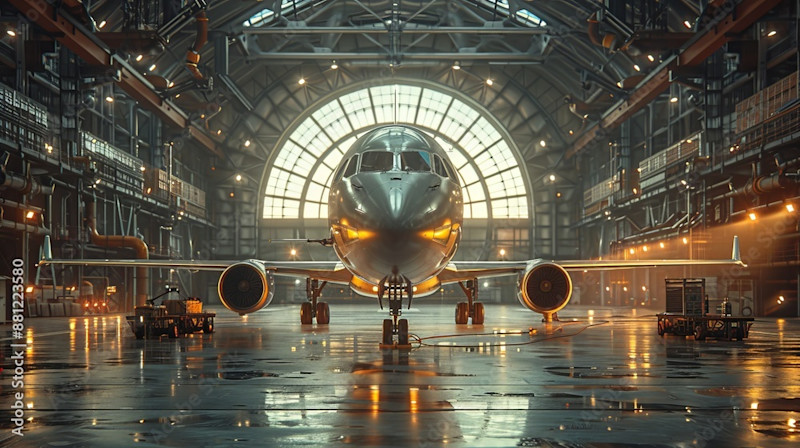The aerospace industry has been evolving rapidly, driven by the need for higher manufacturing rates and enhanced operational efficiency. Automation, augmented by AI, presents significant opportunities for improving these processes. However, its adoption comes with a unique set of challenges, especially given the industry's stringent regulations and the complexity of aerospace manufacturing.
At September’s Annual Member Meeting for the Advanced Robotics for Manufacturing (ARM) Institute, a panel of key figures, including Tim Gaur, Airbus’ senior manager of research and technology, and John Tuohy, the manager of business development for FANUC’s Robodrill Group, discussed crucial challenges and opportunities for automation in aerospace manufacturing. Here are 10 important takeaways.
1. Economic Challenges of Automation
According to Gaur, automation in aerospace is not solely about the acquisition of technology but also about the costs of supporting and maintaining this technology. In industries like aerospace, where production volumes can fluctuate, the economic viability of automation must be thoroughly evaluated. The automation systems must provide a clear return on investment and offer long-term sustainability to justify the significant upfront costs.
2. Technical Challenges of Automation
One of the most significant technical barriers to automation implementation is the spatial constraints within aerospace components and structures. Structures such as wings and control surfaces have limited internal space, which complicates the effective deployment of large-scale automation solutions. Furthermore, many processes in aerospace manufacturing were initially designed to be manual. Automating such processes can be complex and, in some cases, not economically or technically feasible.
3. Human vs. Robotic Capabilities
Tuohy highlighted the difficulty of replicating human versatility with robots. While automation excels in precision and repeatability, human flexibility and problem-solving abilities remain irreplaceable in many scenarios. As a result, automation in aerospace should target specific tasks rather than attempting to emulate the broad capabilities of human workers. This strategic focus allows for optimizing both human and robotic contributions in the manufacturing process.
4. Partnerships in Automation
Partnerships play a crucial role in advancing automation in the aerospace sector. According to Tuohy, large companies like Airbus depend heavily on component suppliers and integrators to develop solutions that are scalable and tailored to specific needs. Collaborations with suppliers who understand the demands of automation are vital to the success of these projects.
5. Manufacturing Rates as a Priority
The aerospace industry faces the constant pressure of fulfilling high demand while maintaining quality. Gaur underscored the importance of increasing manufacturing rates, given the significant backlog in aircraft production. Any new automation technology must contribute to speeding up production to justify its adoption.
6. The Impact of Automation on Jobs
The introduction of robotics in aerospace manufacturing has sparked concerns about job displacement. However, Tuohy argued that while some traditional roles may be eliminated, automation creates new opportunities that require advanced skills. The transition toward more automated processes involves re-skilling the workforce and changing the perception of robotics within the industry.
7. The Role of Management in Automation
Successful automation deployment requires strong management support. Transparent communication regarding the goals and benefits of automation is essential to secure the backing of both leadership and the workforce. Misaligned expectations or unclear communication can result in resistance to automation initiatives.
8. Challenges in Manufacturing Design
One of the biggest challenges in adopting automation lies in balancing the design of new processes with retrofitting existing ones. For example, Airbus has faced challenges when ensuring that legacy designs are compatible with modern automation technologies. Moving forward, designing products with automation in mind from the outset will be critical to overcoming these challenges.
9. The Role of AI in Manufacturing
AI has emerged as a powerful tool for enhancing decision-making within automated systems, providing valuable insights through data analytics. However, AI is not a panacea. For AI to be effective, data must be accurate and trustworthy, and its results must align with business objectives. Trust in AI and data sharing between stakeholders is critical to its successful implementation.
10. The Future of Automation in Aerospace
The future of aerospace manufacturing lies in advancing both automation and inspection technologies. As automation continues to evolve, partnerships between manufacturers and integrators will be key to overcoming technical and economic barriers. The industry must also invest in the continuous improvement of workforce skills to align with these technological advancements.
Automation in aerospace manufacturing offers significant opportunities to enhance efficiency and production rates. However, companies must navigate economic, technical, and human challenges to realize these benefits. Strong management support, strategic partnerships, and workforce development will be essential to the successful integration of automation technologies in the aerospace sector.
The ARM Institute is a Pittsburgh-based private-public consortium designed to accelerate the adoption of robotics and automation within the United States. ARM focuses on AI, robotics, autonomy, and workforce development innovations while partnering with industry to solve local and national challenges.
For more on automation, make sure to check out SPS Atlanta 2025 on Sept. 16-18, 2025, developed by Smart Production Solutions and AMT to further the acceleration of automation and facilitate the exchange of ideas and innovation in automation.






